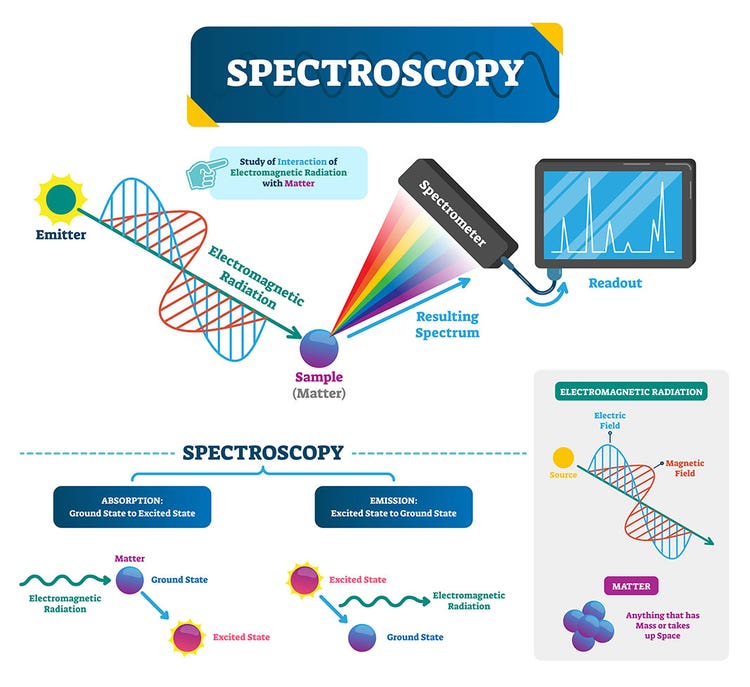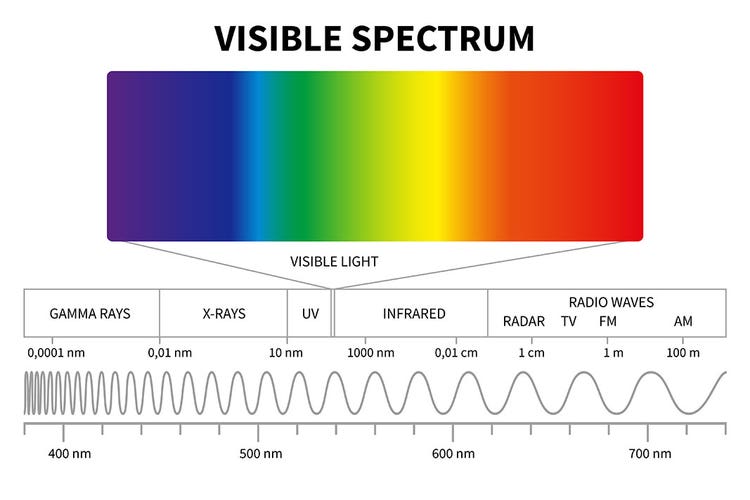What is Spectroscopy?
Spectroscopy tools are valuable for studying the structure, function and dynamics of biomolecules in a wide range of life science applications. The different types of spectroscopies offer unique advantages and can be used in complementary ways to provide a more comprehensive understanding of biological systems.
Spectroscopy is based on the interaction of electromagnetic radiation with matter, which is used to obtain information about a sample’s physical and chemical properties. Several different types of spectroscopies are commonly used in biological research, including ultraviolet-visible (UV-Vis), infrared (IR), fluorescence and Raman.

See how Danaher Life Sciences can help
Types of Spectroscopy
UV-Vis Spectroscopy
UV-Vis spectroscopy is widely used to quantify the concentration of biomolecules, such as proteins and nucleic acids, in a sample by measuring the absorption or transmission of light in the ultraviolet (UV) and visible (Vis) regions of the electromagnetic spectrum. It is also used to monitor changes in their conformation or structure, which can be induced by environmental changes or by adding ligands or other molecules. UV-Vis spectroscopy is also used to study the kinetics of enzyme-catalyzed reactions, as changes in absorbance can be used to monitor the progress of a reaction over time.
UV-Vis spectroscopy is used in clinical applications to quantify the concentration of biomolecules in body fluids such as blood and urine. It is also used to monitor the efficacy of drug treatments and diagnose various diseases, such as liver disease and diabetes.
Infrared (IR) Spectroscopy
IR spectroscopy is used to measure the absorption or transmission of infrared radiation, which is absorbed by the vibrations of chemical bonds in a sample. This technique is useful for identifying and characterizing chemical compounds and for detecting changes in the secondary structure of proteins, as different types of secondary structures exhibit distinct IR spectra. IR spectroscopy can also be used to monitor conformation changes in proteins induced by pH and temperature, or due to the presence of denaturants.
IR spectroscopy is used to identify and characterize chemical compounds in clinical samples, including tissues and body fluids. It is useful for diagnosing diseases such as cancer and neurological disorders, as changes in the IR spectra of these tissues can provide diagnostic information.
Fluorescence Spectroscopy
Fluorescence spectroscopy is used to measure the emission of light from a sample after it has been excited by a light source. It is a sensitive and versatile technique to study the interaction between biomolecules, such as protein-protein interactions, protein-DNA interactions and ligand-receptor interactions. Fluorescence spectroscopy can also be used to study the dynamics of biological processes, such as protein folding, as changes in fluorescence intensity or lifetime can provide information about changes in the microenvironment of a fluorescent probe.
Fluorescence spectroscopy is used in clinical applications to diagnose and monitor diseases such as cancer and cardiovascular disease. It can also be used to monitor the efficacy of drug treatments and to study the dynamics of biological processes such as protein folding.
Raman Spectroscopy
Raman spectroscopy measures the scattering of light by a sample, which provides information about the vibrational modes of chemical bonds in the sample. For this reason, it is utilized to identify and characterize chemical compounds in biological samples, particularly in cases where traditional IR spectroscopy is not applicable. Raman spectroscopy is also used to study the structure and conformation of biomolecules, as changes in Raman spectra can provide information about changes in molecular vibrations induced by changes in the environment or by the addition of ligands or other molecules.
Raman spectroscopy can help identify and characterize chemical compounds in clinical samples, including tissues and body fluids, which makes it valuable for cancer diagnosis and monitoring.
Spectroscopy: Future Applications
Spectroscopy is a powerful analytical tool that has numerous current and potential future applications. As technology continues to advance, there are several emerging areas where spectroscopy is likely to have a significant impact.
One area where spectroscopy is likely to play an increasingly important role is in the field of personalized medicine. With advances in genomics and proteomics, there is a growing interest in using spectroscopy to analyze biomarkers in patient samples to provide individualized treatment plans. Spectroscopy can provide real-time information about the composition and behavior of biological molecules, allowing for more precise diagnoses and treatments.
Spectroscopy will continue to play a crucial role in developing new drugs and therapies. By providing detailed information about the interactions between molecules, spectroscopy can help to identify new drug targets and optimize drug design. Spectroscopy can also be used to study the behavior of drugs in vivo, providing important information about drug metabolism and distribution.
See how Danaher Life Sciences can help
Spectroscopy - Types & Applications
